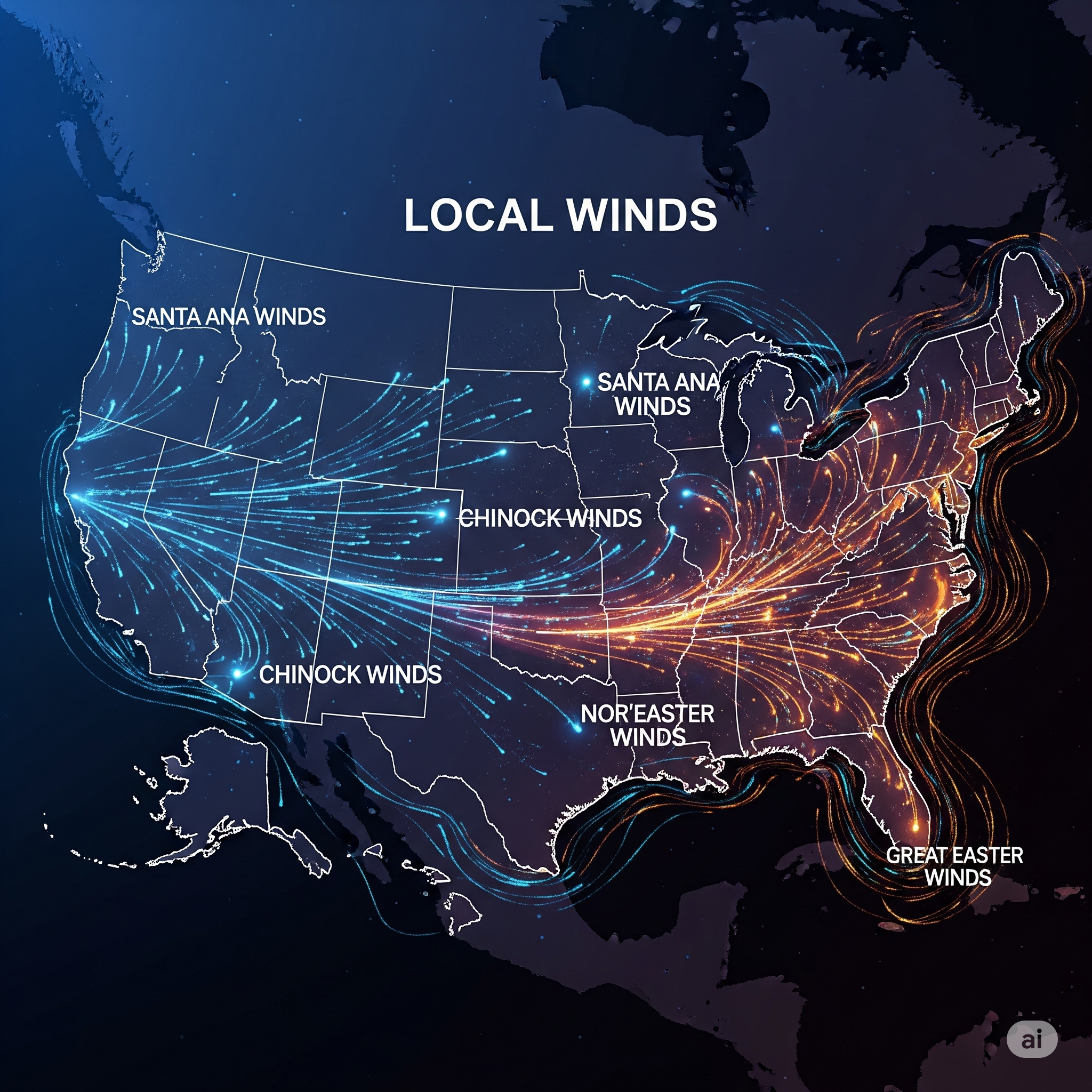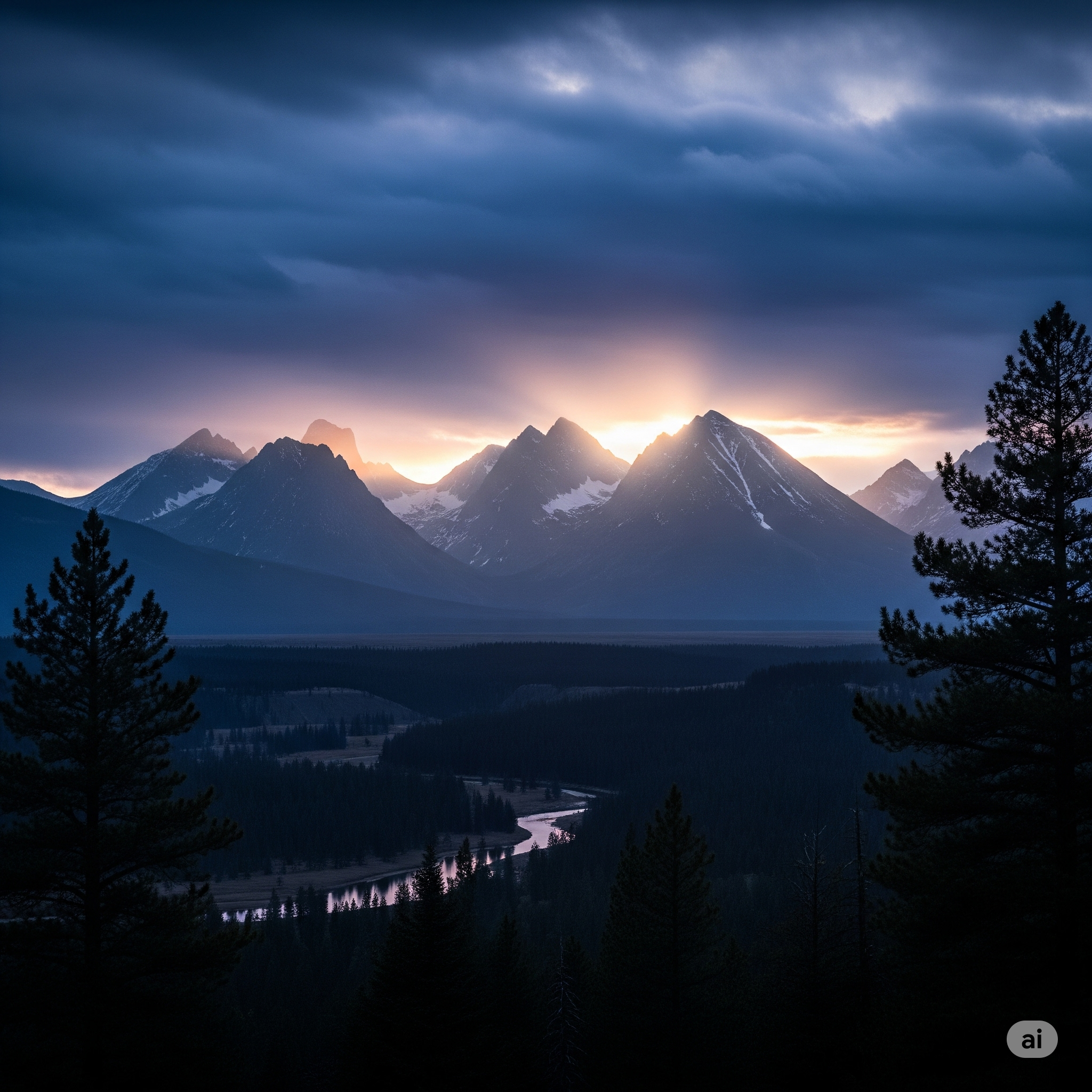Introduction
Alaska, the largest state in the USA, covers over 663,000 square miles and spans a vast range of latitudes and terrains. From the arctic tundra in the north to the temperate rainforests of the southeast, Alaska exhibits one of the most diverse and extreme climates in North America. Its climate and wind patterns are shaped by latitude, topography, ocean currents, and large-scale atmospheric circulation. These elements influence daily life, transportation, infrastructure, wildlife, and human activities, as well as agriculture and subsistence practices in the state.
This article provides a detailed, 100% unique, educational overview of Alaska’s climate, major wind systems, their mechanisms, and their impact on the environment and human life.
1. Geographic and Climatic Zones of Alaska
Alaska’s climate is highly heterogeneous due to latitude, elevation, and proximity to oceans. Broadly, it can be divided into four main climatic zones:
a) Arctic and North Slope
- Location: Northernmost part of Alaska, including Prudhoe Bay and Barrow (Utqiaġvik).
- Climate Type: Arctic tundra; long, extremely cold winters and short, cool summers.
- Temperature Range: Winter averages −20°C to −30°C; summer averages 0°C to 10°C.
- Precipitation: Low (100–200 mm annually), mostly as snow.
- Characteristics: Permafrost dominates the landscape, limiting vegetation to mosses, lichens, and dwarf shrubs.
b) Interior Alaska
- Location: Central regions including Fairbanks and Denali National Park.
- Climate Type: Subarctic; highly continental.
- Temperature Range: Winter averages −25°C to −15°C; summer averages 15°C–25°C, but can exceed 30°C.
- Precipitation: Moderate (300–600 mm), mostly snow in winter.
- Characteristics: Clear seasonal contrasts; extreme temperature swings due to distance from ocean moderation.
c) Southwest Alaska
- Location: Bristol Bay, Aleutian Islands, Kodiak Island.
- Climate Type: Maritime; oceanic influence.
- Temperature Range: Winter −5°C to 0°C; summer 10°C–15°C.
- Precipitation: High (up to 1,500 mm annually), frequent storms.
- Characteristics: Fog, rain, and persistent cloud cover are common; moderate temperatures year-round.
d) Southeast Alaska
- Location: Panhandle, including Juneau, Ketchikan, Sitka.
- Climate Type: Temperate rainforest (oceanic/marine).
- Temperature Range: Winter 0°C to 5°C; summer 10°C–18°C.
- Precipitation: Very high (1,500–3,000 mm), often heavy rain rather than snow.
- Characteristics: Dense forests, glaciers, and abundant rivers; mild winters compared to interior regions due to oceanic influence.
2. Major Wind Systems of Alaska
Alaska experiences a wide range of winds, from gentle sea breezes to violent katabatic gusts. These winds are influenced by mountain ranges, fjords, ocean currents, and seasonal pressure systems.
a) Katabatic Winds
- Definition: Cold, dense air flows downhill from elevated regions.
- Locations: Coastal fjords and icefields in southeast Alaska; Brooks Range.
- Characteristics: Sudden, strong, and cold gusts; can reach hurricane-force in narrow valleys.
- Impact: Hazardous to boats, aircraft, and outdoor activities; contributes to rapid cooling and ice formation.
b) Williwaws
- Definition: Intense, sudden gusts of cold wind descending from mountains to the coast.
- Locations: Aleutian Islands, southeastern fjords, coastal inlets.
- Characteristics: Extremely violent, short-duration wind events; can exceed 150 km/h.
- Impact: Dangerous to maritime navigation and small aircraft; can cause property damage in exposed settlements.
c) Taku Winds
- Definition: Strong katabatic winds descending from glaciers and mountains.
- Location: Near Juneau and Gastineau Channel.
- Characteristics: Warm and dry winds, occurring mainly in late winter and spring; speed often exceeds 80 km/h.
- Impact: Influence microclimates, affect aviation, and can cause localized warm spells that melt snow or ice.
d) Arctic Outflow Winds
- Definition: Cold air flowing from the Arctic Ocean southward into northern Alaska.
- Characteristics: Bitterly cold, persistent winds that lower temperatures significantly, especially during winter.
- Impact: Increase heating demand for homes and buildings; complicate transportation and outdoor work.
e) Aleutian Low and Storm-Driven Winds
- Definition: Cyclonic winds generated by the Aleutian Low, a semi-permanent low-pressure system over the North Pacific.
- Locations: Southwest Alaska, Aleutian Islands.
- Characteristics: Strong, stormy winds, especially in winter; can bring heavy precipitation and rough seas.
- Impact: Influence coastal erosion, marine navigation, and fishing operations; critical for local climate and rainfall distribution.
f) Sea and Land Breezes
- Definition: Local winds caused by temperature differences between land and sea.
- Locations: Coastal communities in southeast, south-central, and southwest Alaska.
- Characteristics: Daytime sea breezes bring moisture inland; nighttime land breezes reverse the flow.
- Impact: Affect microclimates, fog formation, and local weather; moderate temperatures along the coast.
3. Temperature and Seasonal Variations
Winter (October–March)
- Interior and Arctic: Extremely cold; temperatures can drop below −40°C. Snow persists for months.
- Southeast and Southwest: Mild, wet, and windy; snowfall is less severe, except in higher elevations.
- Daylight: Arctic regions may experience polar night, with weeks of darkness.
Summer (June–August)
- Interior: Warm with long daylight (up to 21–24 hours); short growing season.
- Coastal regions: Cool and humid; frequent rain and fog.
- Midnight Sun: Northern Alaska experiences continuous daylight, boosting plant photosynthesis in tundra regions.
Transitional Seasons (Spring & Fall)
- Rapid temperature changes; variable wind patterns; often stormy along the coast.
- Frosts can occur in late spring or early fall, limiting agriculture.
4. Precipitation Patterns
- Interior Alaska: Low to moderate precipitation, mostly snow in winter.
- Southwest and Aleutians: High precipitation with frequent storms; heavy snowfall at higher elevations.
- Southeast Alaska: Very high precipitation due to orographic uplift along coastal mountains; temperate rainforests thrive here.
- North Slope: Minimal precipitation; polar desert-like conditions.
5. Impact of Winds and Climate on Daily Life
Transportation
- Maritime travel: Williwaws, Taku winds, and storm-driven Aleutian winds pose hazards to ships and ferries.
- Air travel: Gusty katabatic winds and storms can delay flights in Juneau, Anchorage, and rural bush airports.
- Roads: Snow, ice, and high winds complicate driving in interior and northern Alaska.
Infrastructure & Housing
- Buildings must be designed for extreme cold, heavy snow, and high winds.
- Heating systems are critical; wind chill increases energy demand.
- Coastal communities face erosion risks during stormy wind events.
Health & Lifestyle
- Cold and windy conditions increase risk of frostbite and hypothermia.
- Winds affect air quality, especially when wildfires occur in summer or smoke drifts from distant regions.
- Traditional subsistence activities (hunting, fishing, ice travel) must account for wind-driven hazards.
6. Impact on Agriculture and Natural Resources
Alaska’s agriculture is limited by short growing seasons, permafrost, and harsh winds, but some activities are possible with adaptation:
a) Crop Farming
- Short-season crops: Potatoes, barley, oats, and certain vegetables grow in interior Alaska.
- Wind barriers: Shelterbelts and greenhouses reduce crop damage from strong winds.
- Soil management: Raised beds and mulch protect against wind erosion and frost.
b) Livestock & Pastures
- Grazing livestock face cold stress from arctic outflow winds; windbreaks and heated shelters are essential.
- Hay production is limited to interior Alaska; wind affects drying and storage.
c) Fisheries
- Coastal winds (Aleutian storms, williwaws) affect fishing safety and navigation.
- Marine currents influenced by wind patterns affect salmon migration and spawning success.
d) Forestry & Natural Ecosystems
- Southeast Alaska’s temperate rainforests thrive due to persistent winds and precipitation.
- Katabatic winds and storm gusts can topple trees, influencing forest succession and management practices.
7. Adaptation Strategies in Alaska
Community & Infrastructure
- Wind-resistant construction: Sloped roofs, reinforced walls, and anchoring systems.
- Emergency preparedness: Alerts for sudden williwaws, Taku winds, and storm surges.
- Heating efficiency: Insulation and backup generators essential for remote communities.
Agriculture & Resource Management
- Greenhouses and hoop houses protect crops from cold and wind.
- Shelterbelts reduce soil erosion and protect livestock.
- Flexible harvesting schedules to avoid storm events.
- Monitoring wind forecasts to ensure safe fishing, forestry, and transportation operations.
8. Unique Features & Fun Facts
- Polar Night & Midnight Sun: North of the Arctic Circle, sunlight can disappear for over 60 days in winter and persist continuously in summer.
- Glacial Winds: Glaciers generate katabatic flows that influence local climate near settlements like Juneau.
- Storm Frequency: Aleutian Low causes some of the stormiest seas in the world, shaping maritime culture.
- Microclimates: Fjords, mountains, and islands create vastly different weather within a few kilometers.
9. Summary
Alaska’s climate is among the most diverse and extreme in the USA, ranging from arctic tundra to temperate rainforests, influenced heavily by wind systems such as williwaws, Taku winds, Aleutian storm winds, katabatic winds, and local sea/land breezes. These winds, combined with temperature extremes and seasonal daylight variations, affect daily life, infrastructure, transportation, subsistence activities, agriculture, and natural ecosystems. Understanding Alaska’s climate and winds is essential for community planning, resource management, and safe, sustainable living in this northern frontier.




